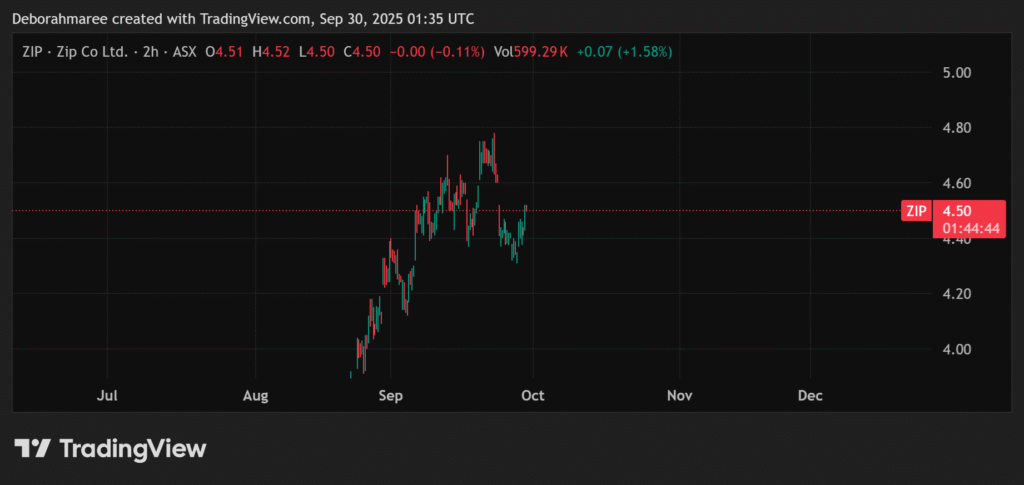Online Trading Masterclass – Elliott Wave & Fibonacci Reveal ZIP’S Next Big Move
Online Trading Masterclass – ZIP’s Next Wave: From the Most Hated Stock to the Most Watched
(Analysis as of Week Ending 29 August 2025) Not financial advice, Training purposes “ONLY”
ZIP is a stock traders either love to hate or hate to love.
It was the ultimate boom-to-bust story: from $0.25 in 2015 to a parabolic run into $14.53 in 2021, before collapsing all the way back to $0.26 in 2023. For most, that was the end of the road. ZIP was written off, thrown into the graveyard of “dead stocks.”
But markets are never that simple. As of week ending 26 August 2025, ZIP has clawed its way back to $4.26, a 1,500% rally from the 2023 bottom. And now the question isn’t “is ZIP dead?” — it’s what wave are we really in, and how far can it go?
🔵 Monthly Supercycle – The Foundation
The monthly chart gives us the truth no one can ignore.
ATL (2015): $0.25
2019 high: $5.86
2020 low: $1.05
2020 high: $10.64
2020 low: $6.21
2021 ATH: $14.53
2021 low: $6.32
2021 high: $9.11
2022 low: $0.44
2022 high: $1.72
2023 low: $0.26
2024 high: $3.56
2025 low: $1.86
Current (week ending 29 Aug 2025): $4.26 (high $4.33 / low $2.98 / open $3.20)
📌 Retracements off ATH ($14.53):
25% = $3.80 (already reclaimed)
50% = $7.27 (next battleground)
75% = $10.90 (macro target)
Online Trading – Monthly Patterns Confirming the Reset
On the monthly chart, three huge patterns confirm ZIP’s new cycle:
1. Double Bottom: $0.26 in 2015 and 2023.
2. Falling Wedge: The 2021–2023 collapse broke upwards in late 2023.
3. Accumulation Base: Sideways chop in 2023–2024 before the 2025 breakout.
These aren’t textbook drawings — they’re live market structures, and they all screamed “trend reversal” before the crowd caught on.
⸻
The monthly structure shows a completed Elliott 5-wave advance into 2021, a brutal ABC corrective reset into 2023, and the ignition of a new cycle.
🔴 Weekly Breakdown – The Impulse in Motion
The weekly chart since the 2023 reset is a masterclass in Elliott Wave.
Wave (1): 0.26 → 1.60 (+516%)
Wave (2): down to 1.06 (40% retrace of W1)
Wave (3): up to 3.06 (1.5× W1, extended impulse)
Wave (4): down to 2.65 (60% retrace of W3 — deep, but valid)
Wave (5): in play now, trading 4.26 into late August 2025
📌 Online Trading – Weekly Wave 5 Target Zones (confluence):
2.0× W1 = $4.53
W5 = W3 = $4.98
1.618× W3 = $5.09
2.618× W1 = $5.36
Stretch target = $5.90
👉 This is why traders are glued to ZIP right now: the $4.90–5.10 zone is stacked with overlapping fib extensions. That’s no coincidence — it’s where the big money pays attention.
🟢 Daily Micro – The Short-Term Roadmap
The daily subwaves zoom in on the current action:
wave i: 1.08 → 1.81 (+67%)
wave ii: down to 1.51 (41% retrace)
wave iii: 1.51 → 3.54 (2.78× wave i, classic extended third)
wave iv: 3.54 → 2.98 (27.6% retrace, shallow/clean)
wave v: in progress, 2.98 → 4.26 (current)
Daily fib projections (from 2.98 low):
2.0× = $4.44
2.618× = $4.89
Equality with wave iii = $5.01
👉 Once again, the daily lines up with the weekly: $4.90–5.10 is the magnet.
⚡ Indicators Back the Structure
Volume: Expanding on impulses, fading on pullbacks — perfect trend confirmation.
RSI: Strong, approaching overbought — watch for divergence into $4.98.
Moving Averages: Bullish cross right at $3.80, same as the 25% ATH retrace level → a textbook confluence signal.
🎯 Confluence Hot Zones
The market gives clues, but only if you know where to look.
$3.20–3.80: Major support (macro 25% retrace + MA cross + breakout base).
$4.90–5.10: Magnet resistance (weekly W5 target + daily W5 extension + historical supply).
$7.27: 50% retrace of ATH — the line in the sand for the next phase.
Time, Price & Pattern – The Gann Perspective (Weekly Update 18 Sept 2025)
Most traders only focus on price. But W.D. Gann taught that the real story unfolds when time and price move in balance.
On ZIP’s weekly chart, we can use a Gann Fan to frame that balance.
Each fan angle works like a potential path:
• 1×1 = balanced time and price.
• Steeper angles = acceleration phases.
• Flatter angles = slower stabilisation paths.
📊 What it tells us (in simple terms):
• ZIP has recently pushed above the balance line, showing strength.
• Momentum tends to accelerate when prices hold above the steeper angles.
• If it falls back, the balance line becomes the critical support zone.
⚠️ Note: exact fan placements can vary depending on settings. We focus on the principle, not the perfect pixel-placement.
What A Chart Shows
It tells us
• Price is moving ahead or below of balanced time-price growth → showing strength or weakness.
• The fan acts like a ladder of support and resistance: if price respects a 2×1 line, momentum continues steeply.
Why It Matters
Most traders miss this: when time cycles (weeks/months) and price levels hit a fan angle together, those are the points where the market often reacts the hardest.
For ZIP, the confluence now sits between $4.20–$4.50 along the fan lines. That’s why this region is attracting attention — it’s not just “price resistance,” it’s a time-price intersection.
⸻
📌 Want to chart this yourself?
• We build every fan, Elliott Wave, and Fibonacci retracement directly in TradingView (free version available).
• If you’re new, start with our Resource Hub for step-by-step guides.
• And don’t miss our Facebook Group where we break down live charts like ZIP in real time.
⚠️ Quick Note: This isn’t financial advice. This is education — showing how traders use Gann tools to frame price, time, and pattern. Always do your own research or consult a licensed advisor.
If you want to set up Gann Fans, Elliott Waves, and Fibonacci retracements like this yourself, you’ll need the right tool
Want to dig deeper? Everything we teach is broken down step-by-step in our Resource Hub — the one-stop shop for beginners learning technical analysis.
Trading for Beginners: The Ultimate Resource Hub
And if you don’t want to do it alone, come share your charts, ask questions, and learn with us inside our Facebook Group for Beginners.
https://www.facebook.com/groups/1762189641350929
⸻
⚠️ Quick Note
Everything in this Masterclass is education only. It’s designed to show you how traders think, not to tell you what to buy or sell. Always do your own research, or speak to a licensed advisor before making financial decisions.
The Blueprint
This is how we trade smarter, not harder:
Monthly → set the rails.
Weekly → map the wave count.
Daily → execute on subwaves.
Indicators → confirm momentum.
Confluence zones → define entries and exits.
As of week ending 26 August 2025, ZIP is pressing into its first true resistance cluster since the 2023 bottom. Hold above $3.80, and the path opens to $4.98–5.10 in the near term, with $7.27 as the next macro target.
Final Word & CTA
ZIP was dismissed as a dead stock at $0.25. Today it’s at $4.26 and pressing higher, with the charts screaming Elliott structure, volume confirmation, and fib confluence.
This isn’t noise. This is a wave in motion.
👉 If you want to see these levels in real time, chart them, and learn to catch the next wave before the crowd — you need the right tools.
That’s why we use TradingView.
Don’t wait for headlines to tell you ZIP is back. The market is already telling you. The next wave is building now.
From the 2023 bottom, ZIP has already built a new Elliott impulse sequence:
• Wave 1: $0.26 → $3.56.
• Wave 2 retrace: $3.56 → $1.08.
Online Trading – Indicators Reflecting Price
Technical analysis is powerful when price + time + indicators all align.
• RSI (Monthly):
• Overbought >80 at the 2021 ATH.
• Bullish divergence at the 2023 double bottom.
• Back above 50 in 2025 → momentum reset confirmed.
• MACD (Monthly):
• Bearish cross mid-2021 started the crash.
• Bullish cross mid-2024 confirmed the breakout.
• EMA (20/50):
• Price sat below these moving averages for years.
• Crossed back above in 2025 — a true cycle reversal.
• Volume:
• Faded during the collapse (capitulation).
• Surged into the 2023–2025 recovery rally (accumulation).
📌 When RSI, MACD, EMA, and Volume all confirm the same price zones, you’re not guessing anymore. You’re trading confluence.
⸻
Online Trading – Confluence Hot Zones
• $3.20–$3.80 Zone:
25% Fib retrace.
2024 resistance.
EMA alignment.
✅ Breakout confirmed in 2025.
• $4.90–$5.10 Zone:
Wave 5 target overlap (weekly + daily).
2.0× Wave 1 = $4.53, W5 = W3 = $4.98, 1.618× W3 = $5.09.
🎯 Magnet resistance — next battleground.
• $7.27 Zone:
50% retrace of ATH.
2020 resistance.
📌 Long-term macro magnet.
This is what pros mean when they say “time, price, and pattern must coincide.”
⸻
Online Trading -Tools We Used
This entire analysis was built with:
• Fibonacci retracements and extensions
• Elliott Wave counts
• RSI, MACD, EMA crossovers
• Volume analysis
👉 All of it was done on TradingView, my go-to trading tool. Check out Why TradingView is my NUMBER 1 Trading Tool, CLick Here
If you want to chart like this, track Elliott Waves, and run your own Fibonacci set up click link below
⸻
From Monthly to Weekly to Intraday
This blog covered the monthly supercycle view.
But real traders break it down further:
• Weekly charts → show the primary Elliott waves inside the supercycle.
• Daily/intraday charts → show the subwaves and trade setups (entries, stops, targets).
That’s how you move from theory → actual trading.
📌 I’ll publish the Weekly chart Breakdown below (to show how we’re tracking the current Wave 3 in detail. After that, we’ll drill down to intraday
⸻
Online Trading – Conclusion
ZIP was the most hated stock in Australia. From $14.53 to $0.26, most thought it was dead.
But online trading isn’t about headlines — it’s about cycles.
And right now, ZIP has all the technical confirmations of a stock that’s back:
• Double bottom at ,$.025,$0.26.
• Breakout above $3.63.
• Indicators (RSI, MACD, EMA, Volume) aligned.
• Fibonacci targets $5.00 → $6.20 → $7.27 → $10.90.
This isn’t hype. It’s technical analysis at work.
All the charts in this report were created on TradingView.
If you want to learn Elliott Wave, Fibonacci trading, and technical analysis the way I do → Click Here to learn all about TradingView and why I use it for every Trade
Want to learn more?
All other Helpful training resources can be found right here in one place at Trading for Beginners: The Ultimate Resource Hub
Check out the Monthly Chart of Zip Here
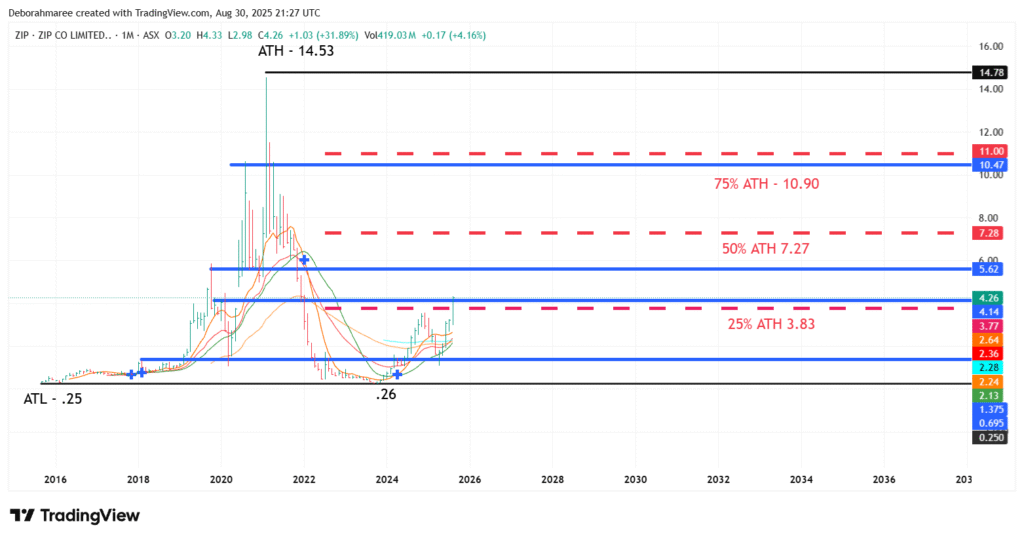
Check Out The Weekly Chart of Zip week ending 29-08-25
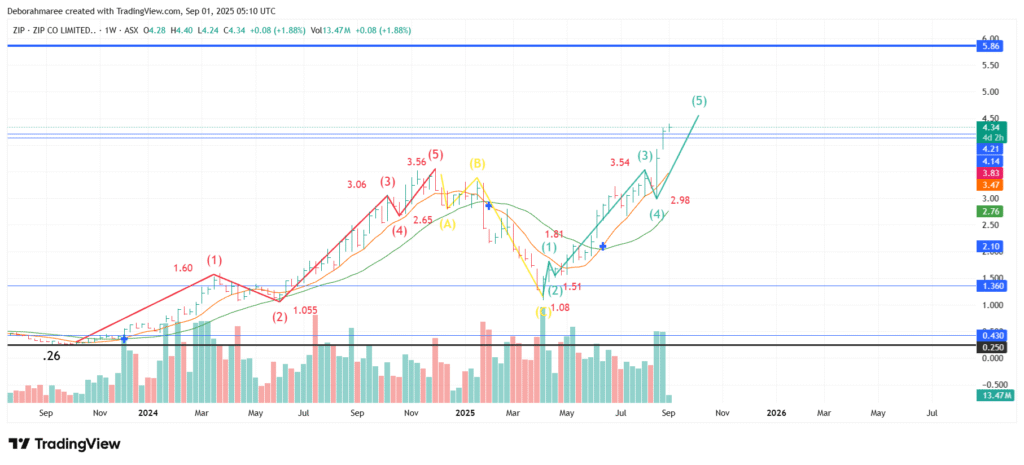
📌 Alternative View: John Murphy’s Classic TA Lens
If Elliott Waves feel a little complex, here’s how the exact same picture looks through the lens of classic technical analysis — the kind of trend, support, and volume approach made famous by John Murphy.
Trend: The chart is showing a clear uptrend — higher highs and higher lows since the 2023 bottom.
Support & Resistance: Key support sits around $3.20–$3.80, while resistance is pressing at $4.90–$5.10.
Volume: Rising volume on rallies, lighter volume on pullbacks — a textbook confirmation of trend strength.
👉 Murphy’s takeaway: Even without Elliott Wave labels, the chart confirms ZIP is in a strong bullish phase, with resistance overhead and support well-defined below.
Checkout Daily Chart of Zip week ending 29-08-25
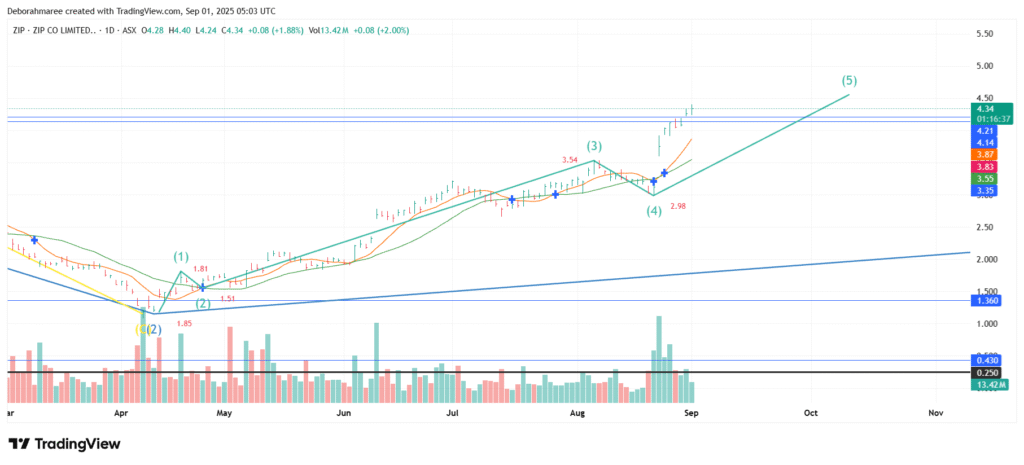
The $4.90–$5.10 Decision Zone
You might notice there’s no neat horizontal line at $4.90–$5.10 on the chart. That’s because this zone doesn’t come from a single support or resistance level — it comes from multiple tools overlapping.
Elliott Wave: Both the weekly Wave (5) and daily subwave v project into this area.
Fibonacci: Extensions of earlier waves cluster here — $4.90, $4.98, and $5.09.
History: Old supply often flips into new resistance, and this area lines up with prior battlegrounds.
Psychology: $5.00 is a round number, and traders naturally anchor to round levels.
👉 When price zones come from confluence — multiple tools pointing to the same range — they act as decision zones. Traders watch closely because this is where momentum often shifts.
NEW UPDATES:
Update – 12 September 2025 (Close: $4.51)
Since publishing this masterclass on 29 August 2025, ZIP has continued to evolve technically. On Friday, 12 September 2025, ZIP closed at $4.51. This brings us into a new discussion around supply and demand levels, which are critical for short-term traders looking at intraday or swing opportunities.
Supply & Demand Snapshot:
• Demand Zone: $3.80 – $4.10
• Break Block Zone: $4.20 – $4.30
• Fib 0.5: $4.00
• Fib 0.618: $3.85
• Supply / Resistance: $4.90
This means that if ZIP pulls back into the demand zone ($3.80–4.10), it could offer high-probability re-entry opportunities for traders. On the upside, the key supply zone around $4.90 remains the magnet level we are watching.
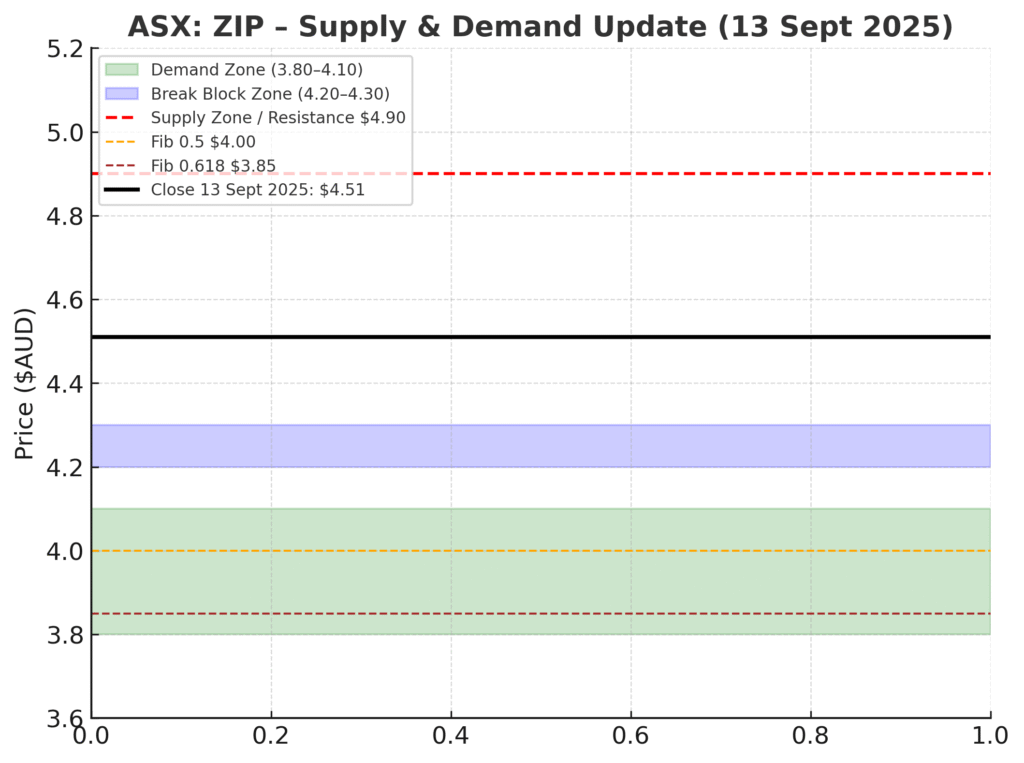
Below is the updated chart Update12 September 2025 (Close: $4.51)
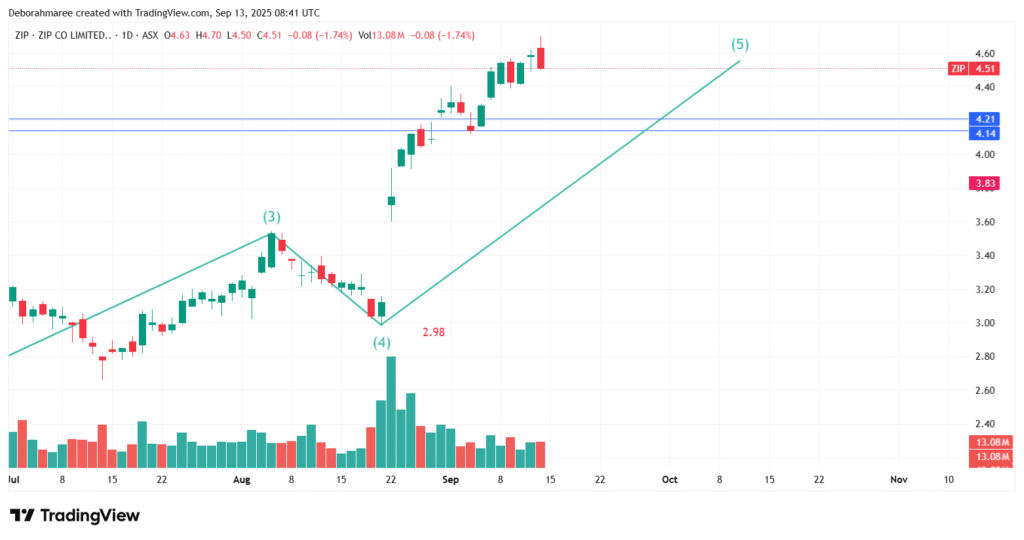
⸻
⚠️ Important Teaching Note
Supply and demand trading is powerful, but it’s not where beginners should start. These setups rely on understanding price action, Fibonacci, and Elliott Wave confluence — tools that only make sense once you’ve built a strong trading foundation.
If you’re brand new, we recommend you:
1. Start with the Trading Blueprint → a step-by-step roadmap to build trading as a business.
2. Explore the Resource Hub → free tools and guides to strengthen your basics.
3. Join our Facebook Group → where we break down live examples like ZIP in real time.
Only once you have the foundation should you move into advanced concepts like supply and demand trading.
Weekly Update – Trendline Lesson (Week Ending 21 Sept 2025)
(Education only, not financial advice)
One of the simplest but most powerful tools in technical analysis is the trendline. On ZIP’s weekly chart, we can now confirm a valid trendline using three clean anchor points:
• $1.08 low (Apr 2025)
• $1.84 higher low (May 2025)
• $2.98 higher low (Aug 2025)
With three touches, the line is confirmed under classical TA rules. Each higher low has respected the same slope, showing ZIP is riding a clear wave of support.
📌 Why it matters: As long as price continues to respect this line, momentum remains intact. A break below it would shift the conversation to the next layer of support — but for now, this is the backbone of the current advance.
⚠️ Remember: this isn’t financial advice. This is education — showing how trendlines are built, tested, and confirmed in real time.
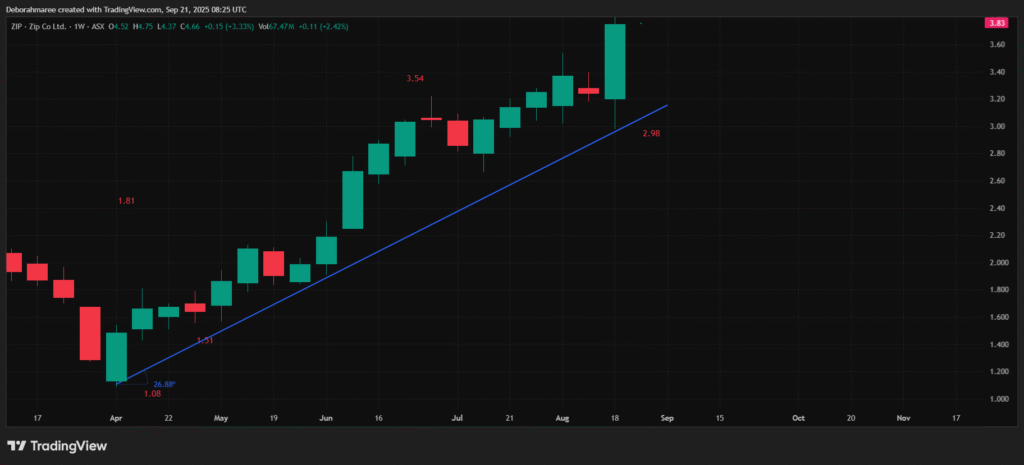
(Update as of 24 September 2025 – Not financial advice, education only)
Back on 26 August 2025, we mapped out ZIP’s path. The big call?
That the $4.90–$5.10 zone was the magnet — a cluster where Fibonacci, Elliott Wave, and historical resistance all overlapped.
Fast forward less than a month, and ZIP did exactly what the charts suggested. It surged from the $3.80 breakout base and tapped into that resistance band like clockwork.
Why It Matters
• Elliott Wave 5: We said the final leg of the impulse was in play. That leg has now stretched right into our projected targets.
• Fibonacci Confluence: 2.0× Wave 1, 1.618× Wave 3, and equality with prior waves all stacked in the same range. Price respected it perfectly.
• Confirmation: Momentum and volume both supported the move — no guesswork here.
This isn’t hindsight bragging. It’s the power of combining time, price, and pattern. Traders who had these levels marked were prepared while the crowd was still asking “is ZIP even alive?”
What’s Next?
The battleground is here. $4.90–$5.10 is no ordinary number — it’s decision time.
• Hold → the door opens toward the bigger retrace at $7.27.
• Fail → we watch the demand zone at $3.80–$4.10 for re-entries.
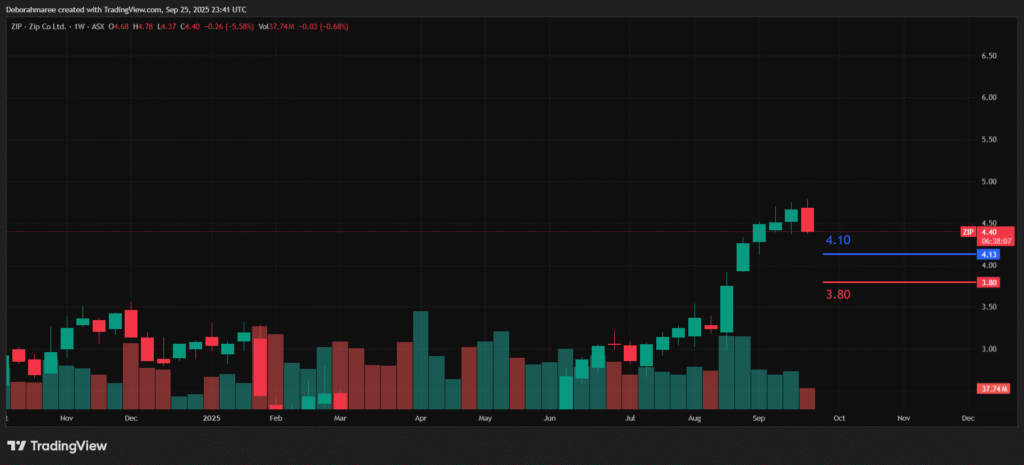
📅 Masterclass Update – 29 Sept 2025
Trailing Stops: Protecting Gains on ZIP
ZIP has done exactly what we mapped — surging from the $3.80 breakout base into the $4.90–$5.10 resistance band. That brings us to today’s lesson: how to protect profits once you’re in.
On the chart above, we’ve plotted a trailing stop loss using TradingView’s built-in ATR tool (Pro version required). Right now, it sits around $3.72, about 14.5% below the current close ($4.35).
👉 Why it matters:
• It “locks in” gains as price rises.
• It adapts to ZIP’s volatility (ATR expands/contracts with swings).
• It takes the emotion out of deciding when to exit.
⚠️ Important Teaching Note:
This is not the same as a true swing-low stop (e.g., the $2.98 low from Aug 2025, shown with the red arrow). Swing stops are further away, giving the trade more breathing room but risking more downside. ATR trailing is tighter, better for traders looking to protect profits actively.
We’ll go deeper into the swing-low method inside the e-book. For now, this update shows how TradingView makes trailing stops plug-and-play — a powerful way to manage trades in real time.
📌 Key Zones to Remember:
• $3.80–$4.10: Demand (buyers reload).
• $4.90–$5.10: Resistance (magnet band).
• $7.27: Next macro target (50% ATH retrace).
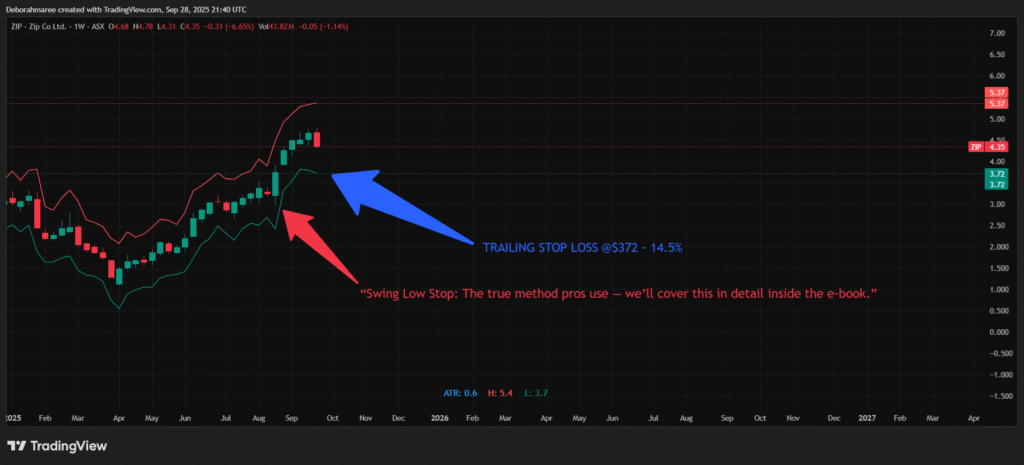
Masterclass Update -30 Sept 2025 – Candel Stick Snapshot
(Education only, not financial advice)
Look at this chart. Price dipped hard into the $4.35 zone last Friday (26th), then snapped back on Monday after the buy-back announcement. Today, we’re trading around $4.50 — but notice what’s really happening in the candles.
👉 Small-bodied candles. Long wicks above and below. Side-by-side clusters.
This is what we call indecision.
By itself, indecision means nothing more than “the market is pausing.” But when you zoom out, context is everything:
Support: Buyers have stepped in multiple times around $4.40–$4.45. That level is now acting like a floor.
Resistance: Sellers are leaning in near $4.60. The big battleground remains $4.90–$5.10 — the zone we’ve been teaching for weeks.
Pattern: These indecision candles form the “pause” inside a bigger consolidation structure. Think of it as the market catching its breath before the next move.
📌 Why it matters:
If price pushes above $4.60, this cluster acts as a bullish continuation → doors open back to $4.90–$5.10.
If price slips under $4.40, the floor breaks, and we could see a retest of $4.20 or even the demand zone around $3.80.
⚡ Trading lesson: A single candlestick (like a Doji) is just noise. A cluster of candles at a key level? That’s a signal — especially when it lines up with the bigger Elliott Wave and Fibonacci roadmap we’ve been following all month.
